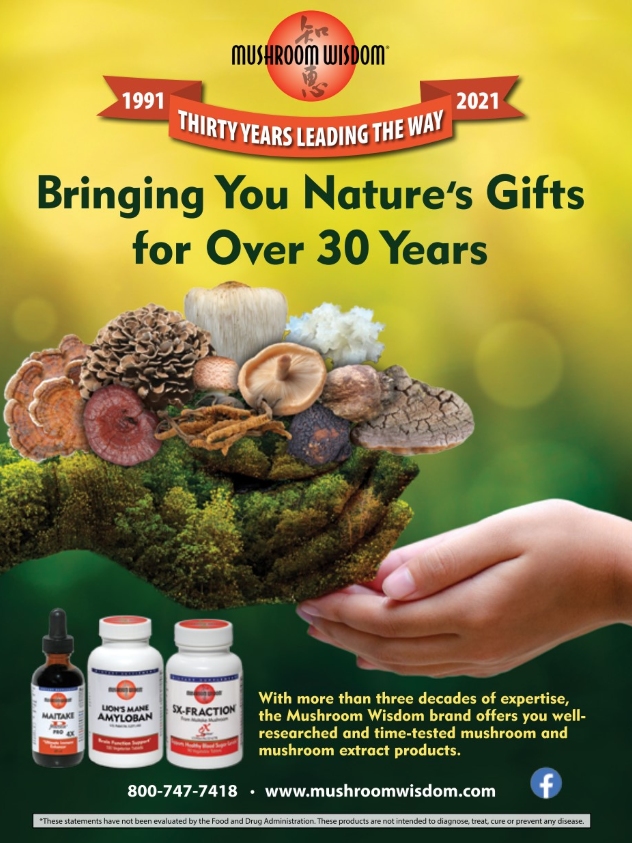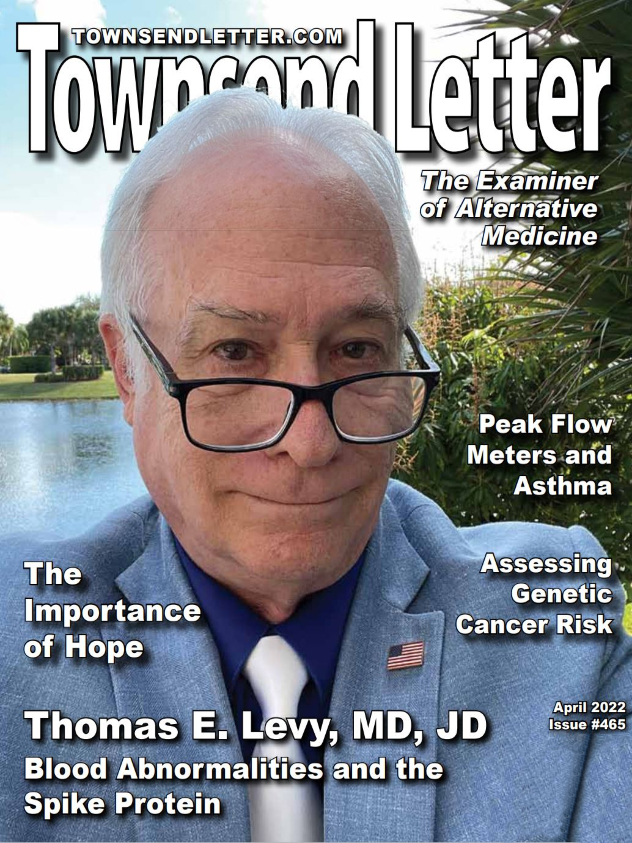~by Jule
Macular Degeneration and Taurine
While anecdotal reports cannot have the weight of controlled research, those reports often provide clues for new avenues of treatment that are later confirmed in large studies. In Volume 2 of Dr. Zamm’s Medical Mysteries Series, Alfred V. Zamm, MD, shares his own experience after being diagnosed with age-related macular degeneration (AMD). (Volume 1, GERD: A Manganese Nutritional Deficiency, was reviewed in Townsend Letter, November 2021.)Degeneration of the macula, the area on the retina where sharp vision occurs, leads to vision loss. It has no known cure, Zamm’s ophthalmologist told him, although a combination of vitamins A, C, E, and a few other nutrients might help (See Grossman article in this issue for more on this).
Since he had already been taking vitamins for years, Dr. Zamm decided he was going to have to solve this mystery himself if he wanted to save his vision. He arbitrarily decided to take L-methionine (500 mg/twice a day), a sulfur-containing amino acid that he had researched and used before, and kept track of his vision using the Amsler grid. L-Methionine is the precursor to L-cystine, which is precursor to the amino acid taurine. With methionine, the AMD symptoms largely resolved for about a year. Then, whether it was because he had reduced his consumption of beef and pork (important sources of taurine) or because he was a year older, the symptoms began to return. Increasing the dosage of methionine did not help.
While searching for alternatives, Dr. Zamm came upon veterinary research about cats (whose bodies cannot make taurine) that developed retinal degeneration and, eventually, went blind when placed on a taurine-free diet. If they were given taurine before retinal cells died, the cats’ vision would return. Dr. Zamm began taking 500 mg of taurine three times a day with meals. (He weighs about 170 lbs.) The taurine helped his “’sick’ and dysfunction” retinal cells recover but could not totally restore his vision: “…taking taurine in time was fortuitous in saving enough of my rescuable macular cells to produce an excellent result—but not a 100% cure.”
In Macular Degeneration A Solution, Dr. Zamm also explains that heavy metal poisoning from mercury and other toxic metals have a role in AMD; heavy metals “disable enzymes that are involved in the metabolic conversion of sulfur-containing amino acids that produce taurine.” He includes information about selenium, which is needed for several enzymes, including glutathione peroxidase (detoxification). Other factors that can contribute to blurred vision include allergies, chemicals, hypoglycemia, and visual stressors such as reading small print on a computer. For those who like to dig deeper, Dr. Zamm has provided a list of research studies that he found useful. This little, lay-friendly book highlights an amino acid that may be key to preserving vision. It is available from Amazon.
Mercury Amalgams’ Effects on Health
The neurotoxic effects of mercury have been known for decades; and after 20 years of reviewing scientific literature and holding public discussions, the US Food and Drug Administration (FDA) finally recommended that mercury amalgam fillings not be used in “certain high-risk populations.” The agency’s September 24, 2020, recommendation identifies pregnant women and their fetuses, women who plan to get pregnant, nursing women and their babies, children (especially under age six), and people with neurological disease, impaired kidneys, or with heightened sensitivity (allergy) to mercury or other components in amalgams as “high-risk.” Based on the FDA statement, International Academy of Oral Medicine and Toxicology calculates that about 60% of the population falls into the high-risk category.
Mercury vapor (gas) is released in small amounts from amalgam fillings during chewing, brushing, teeth grinding, or when drinking hot liquids. Greater exposure occurs when mercury amalgams are placed into or removed from a tooth—which is why FDA does not recommend removing amalgams unless medically necessary (e.g., patient is allergic to filling components). The vapor is inhaled into the lungs and carried throughout the body by the bloodstream. Mercury blocks metabolic enzymes, binding thiol (sulfur; cysteine) and selenium, and causes oxidative stress. Signs of mercury toxicity include mood disorders, sleep difficulties, fatigue, memory problems, tremors, visual and/or hearing changes, impaired coordination, and kidney damage.
Despite issuing a recommendation that affects more than half of the population, FDA did not completely ban mercury fillings: “The weight of the existing evidence does not show that exposure to mercury from dental amalgam leads to adverse health effects in the general population, and its longevity is better than that of alternatives….” But could it be that the correlation between health disorders and mercury toxicity has simply not been identified in the 40% that FDA considers the “general population”?
In 2021, the father-son team, Mark R. Geier, MD, PhD, and David A. Geier published two epidemiological studies that found a correlation between dental amalgams and two common health disorders: asthma and arthritis. The Geiers co-founded the non-profit Institute of Chronic Illnesses, Inc., which researches underlying causes and treatments of chronic disease, and CoMeD, Inc., a non-profit educational group. The Geiers were accredited participants in the United Nations meetings that developed the agreement to curtail mercury pollution, the Minimata Convention on Mercury. Both of their 2021 studies used data from the 2015-2016 National Health and Nutrition Examination Survey (NHANES), whose purpose is to “estimate the number and percentage of persons in the US population and in designated subgroups with selected diseases and risk factors,” according to CDC.
The Geiers looked at asthma incidence among the NHANES adult participants (age 20-80 years) to test the hypothesis that damage from mercury vapor, which is inhaled, would show up as this common respiratory disorder. They compared those who had amalgam fillings to people who had other types of fillings and found, “As the number of dental amalgam filling surfaces increased, the incidence rate of reported asthma increased from 0 among those with 1 dental amalgam filling to a maximum of 3.76 among those with 6 dental amalgam filling surfaces.” For those with >6 fillings, the incidence rate was 2.87; the incidence rate was 3.22 for those with >13 filling surfaces. This association remained statistically significant even after adjusting for covariates (race, gender, socioeconomic status, birth country, age, education level, and serum cotinine).
In the second epidemiological study, the Geiers found a statistically significant dose-dependent relationship between the number of amalgam filling surfaces and incidence of arthritis: “The arthritis rate was significantly increased in the exposed group compared to the unexposed group in the unadjusted (7.68-fold) and adjusted (4.89-fold) models.” Interestingly, arthritis incidence peaked among persons with four to seven amalgam fillings but was significantly decreased among people with 13 or more. In addition to mercury’s overt toxic effects, it is possible that the joint inflammation “may involve an immune-mediated allergic-type reaction to metals,” and greater exposure may eventually suppress the immune response.
Both studies have several limitations, noted by the authors; and like all epidemiological studies, neither proves a cause-effect relationship. Still, the correlations in both papers are supported by case reports and clinical studies that describe remission of these conditions after amalgam removal in some patients. Mercury dental amalgams may be affecting the health of the general population in ways that FDA has not recognized—yet.
FDA. Recommendations About the Use of Dental Amalgam in Certain High-Risk Population: FDA Safety Communication. September 24, 2020.
Geier DA, Geier MR. Reported asthma and dental amalgam exposure among adults in the United States: An assessment of the National Health and Nutrition Examination Survey. SAGE Open Medicine. 2021;9:1-10.
Geier DA, Geier MR. Dental Amalgams and the Incidence Rate of Arthritis among American Adults. Clinical Medicine Insights: Arthritis and Musculoskeletal Disorders. 2021; 14:1-11.
Exclusion-Zone Water and Sulfur
About 20 years ago, Gerald Pollack, PhD, a professor of bioengineering at the University of Washington, and his colleagues identified a fourth phase of water to add to the three we already recognize (solid, liquid, gas). This fourth phase is a gel with a regularized crystalline hexamer structure and a negative charge that excludes colloidal and molecular solutes—hence, its name: exclusion-zone (EZ) water. EZ water is the primary form of water in the body; it forms next to hydrophilic structures such as biological membranes.
Interaction between the negatively charged EZ water and unstructured, bulk water, which has a positive charge, creates energy—like a battery—for cells and tissues in the body. Pollack and colleagues found that UV, radiant, and infrared light promote exclusion-zone growth: “Photons from ordinary sunlight…may have an unexpectedly powerful effect that goes beyond mere heating. It may be that solar energy builds order and separates charge between the near-surface exclusion zone and the bulk water beyond — the separation effectively creating a battery” (https://www.pollacklab.org/research).
In a 2019 paper, Stephanie Seneff and Greg Nigh hypothesize that “it is the sulfate molecule that plays a fundamental role in providing the interfacial negative charge that builds and maintains the EZ in biological systems.” Sulfate promotes structured water (gel). Sulfates (e.g., heparan sulfate, chondroitin sulfate, keratan sulfate, dermatan sulfate) are important components of the extracellular matrix between cells that helps hold the cells together. Sulfate is also present to a lesser extent in the bloodstream where it is balanced by nitrate ions that destructure water to a liquid state, reducing viscosity and permitting good flow. In earlier papers, Seneff and colleagues hypothesized that endothelial nitric oxide synthase (eNOS), an enzyme that makes nitric oxide from arginine and is expressed by endothelial cells lining the blood vessels, “moonlights”; they suggest that eNOS bound to red blood cells synthesizes sulfur dioxide. According to their proposal, eNOS is responsible for maintaining SO4-2 / NO3– balance, resulting in good blood flow and healthy tissue.
Seneff and Nigh propose that vitamin B12 (cobalamin) is necessary for sulfate synthesis. B12 deficiency can result from impaired absorption, from metformin use, and from a strict vegan diet (plants do not produce cobalamin). “In response to cobalamin deficiency, stored taurine [a sulfur-containing amino acid] in the brain can be mobilized as a resource to boost sulfate levels, systemically,” they write. But that results in damage to the myelin sheath.
Sulfate is not often highlighted as an essential nutrient, but it deserves more attention, if it has a role in maintaining the exclusion zone, as Seneff and Nigh propose. In addition to B12, they say other nutrients that facilitate the production and/or utilization of sulfate include coenzyme Q10, vitamin D, vitamin C, curcumin, and resveratrol. “These are, perhaps not coincidentally, among the nutrients with the strongest health-supporting evidence,” the authors state. “While their role in sulfur metabolism is virtually never mentioned in articles on their health benefits, we propose that it may be as significant as their antioxidant and other properties.”
Seneff S, Nigh G. Sulfate’s Critical Role for Maintaining Exclusion Zone Water: Dietary Factors Leading to Deficiencies. WATER. December 18, 2019.











